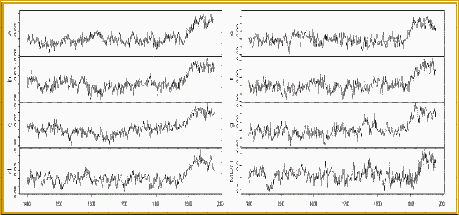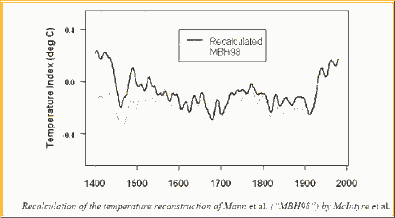The hockey stick fiasco
Part 2: An artefact of poor mathematics
Not long after the hockey stick was published, shock was to stagger the climate-change establishment when two Canadians, Stephen McIntyre, an engineer and brilliant mathematician, and Ross McKitrick, a climate scientist, uncovered a fundamental mathematical flaw in the computer program that was used to produce the MBH98 hockey stick.
In his original publications of the hockey stick, Mann was supposed to have used a standard method known as principal component analysis, or PCA, to find the dominant features in a set of more than 70 different climate records.
McIntyre and McKitrick obtained part of the programme that Mann et al. had used, and they found serious problems with it. Not only did the programme not do conventional PCA, but it handled data normalisation in a way that could only be described as mistaken.
To illustrate the point, McIntyre and McKitrick generated graphs using the Mann et al. algorithm using random, computer-generated ‘red noise’ (i.e. random numbers) and added Mann’s graph compiled from the proxy temperature datasets.[1]
In these eight graphs, it is not easy to see which in Mann’s hockey stick graph and which are the random noise graphs.
McIntyre et al. also tested the algorithm of Mann et al. without the bristlecone-pine data, whereupon the the Little Ice Age appeared. They also found that Mann et al. had excluded from their calculations a single dataset covering the later mediaeval warm period, which had been stored in a computer file marked “CENSORED_DATA”. McKitrick et al. ran the Mann et al. computer model including the missing dataset, and found that the mediaeval warm period reappeared.[2-3]
McIntyre and McKitrick had difficulty getting their findings published, they eventually were. And they caused some consternation in the scientific world. For example, Philip Muller, a physicist at Berkeley, said that the two Canadian scientists’ work:
‘…hit me like a bombshell, and I suspect it is having the same effect on many others. Suddenly the hockey stick, the poster-child of the global warming community, turns out to be an artefact of poor mathematics.’
So, what is probably the most important piece of evidence supporting a man-made component in global warming turns out to by be a work of fiction.
References
1. McIntyre, S., and R. McKitrick,: Corrections to the Mann et al. (1998) proxy database and northern hemispheric average temperature series. Energy Environ 2003; 14: 751–771.
2. McIntyre, S., and R. McKitrick. Hockey sticks, principal components, and spurious significance. Geophys Res Lett 2005; 32(3), L03710, doi:10.1029/2004GL021750.
3. McIntyre, S., and R. McKitrick. The M&M critique of the MBH98 Northern Hemisphere climate index: Update and implications. Energy Environ 2005; 16: 69–99.)
Part 1: The hockey stick and real life | Part 2: An artefact of poor mathematics
Last updated 8 March
2009
Related Articles

 HOME
HOME




